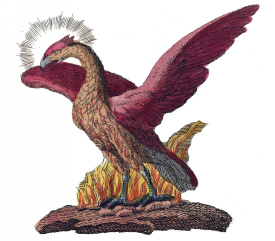A phoenix bird also shows up in the Septuagint (a Greek version of the Old Testament dated to the third century B.C.), Vulgate (Latin version of Scripture compiled by Jerome in the fourth century), and some commentaries for Job 29:18.
The Hebrew word khole (Strong's Concordance #H2344), translated as "sand" in the KJV, is interpreted as referring to the phoenix bird in the Jewish Publication Society Bible and other sources.
Then I said: "I shall die with my nest, and I shall multiply my days as the phoenix;" (Job 29:18, JSP of 1917).
Then I thought: With my nest I shall expire, And like the phoenix, have a long life (Job 29:18, Keil and Delitzsch Commentary).
Keil and Delitzsch's Commentary justifies its translation of Job 29:18 to include the phoenix bird as follows.
"That this bird is none other than the phoenix, is put beyond all doubt by the Midrashim (collected in the Jalkut on Job, §517) . . .
"On the contrary, we must immediately welcome a reference to the Arabico-Egyptian myth of the phoenix, that can be proved, in a book which also otherwise thoroughly blends things Egyptian with Arabian . . . " (Keil and Delitzsch Commentary, comments on Job 29:18 - 20).

The Midrashim is an early Jewish interpretation of Biblical text. Other than possibly referring to the animal, Scripture is unfortunately silent regarding the appearance of this creature.
Traditions
In mythology, the phoenix is a bird that is associated with the sun and can be reborn. Every five hundred years, according to some popular legends, it dies in flames and is reborn out of its own ashes. S. Cyril of Jerusalem, a Catholic church "father" who lived during the middle of the 4th century A.D., stated the following regarding this legendary animal.
"But the Greeks ask for a resurrection of the dead still manifest; and say that, even if these creatures are raised, yet they had not utterly mouldered away; and they require to see distinctly some creature rise again after complete decay. God knew men's unbelief, and provided for this purpose a bird, called a Phoenix . . .
"For it makes itself a coffin of frankincense and myrrh and other spices, and entering into this when its years are fulfilled, it evidently dies and moulders away. Then from the decayed flesh of the dead bird a worm is engendered, and this worm when grown large is transformed into a bird . . . becoming fledged and a full-grown Phoenix . . ." (Early Church Fathers: Second Series, Volume 7, Lecture XVIII).
Clement of Rome, who died around 100 A.D., is considered one of the "fathers" of what would become the Roman Catholic Church. He is possibly the first person to use this bird to teach Christian doctrines. He uses it, in his first Epistle to the Corinthians, as a symbol of Jesus' resurrection from the dead (History of the Christian Church, Volume 2, Clement of Rome).
According to the Talmud, the phoenix (Hol) was the only animal who refused to eat the forbidden fruit from the tree of the knowledge of good and evil. Because of its obedience, God not only allowed it to stay in the Garden of Eden but also gave it immortality.